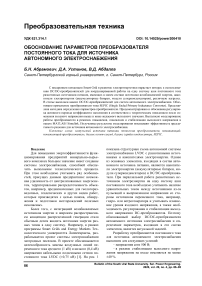Обоснование параметров преобразователя постоянного тока для источника автономного электроснабжения
Автор: Абрамович Борис Николаевич, Устинов Денис Анатольевич, Абдалла Ваэль Джозеф
Журнал: Вестник Южно-Уральского государственного университета. Серия: Энергетика @vestnik-susu-power
Рубрика: Преобразовательная техника
Статья в выпуске: 4 т.20, 2020 года.
Бесплатный доступ
С внедрением концепции Smart Grid в развитие электроэнергетики нарастает интерес к использованию DC/DC-преобразователей для координированной работы на одну систему шин постоянного тока разнотипных источников питания, имеющих в своем составе источники возобновляемой энергии, накопители электроэнергии (аккумуляторные батареи, модули суперконденсаторов), различную нагрузку. В статье выполнен анализ DC/DC-преобразователей для систем автономного электроснабжения. Обосновано применение преобразователя типа SEPIC (Single Ended Primary Inductance Converter). Представлена методика определения параметров преобразователя. Продемонстрирована и обоснована регулировка активного периода коэффициента заполнения в соответствии с теоретическим поведением после изменения входного напряжения выше и ниже желаемого выходного значения. Выполнено моделирование работы преобразователя в режимах повышения, понижения и стабилизации выходного напряжения в пакете MATLAB / Simulink. Полученные результаты моделирования показывают эффективность предлагаемого решения для источника автономного электроснабжения.
Импульсный источник питания, топология преобразователя, повышающий-понижающий преобразователь, баланс вольт-секунд, баланс заряда конденсатора, SEPIC
Короткий адрес: https://sciup.org/147234082
IDR: 147234082 | УДК: 621.314.1 | DOI: 10.14529/power200410
Текст научной статьи Обоснование параметров преобразователя постоянного тока для источника автономного электроснабжения
Для повышения энергоэффективности функционирования предприятий минерально-сырьевого комплекса большое значение имеет создание системы электроснабжения, способной обеспечить выполнение технологического процесса. При этом необходимо учитывать ряд особенностей, присущих данным предприятиям: возможная удаленность от централизованных энергосистем, территориальная рассредоточенность объектов, например, предназначенных для геологоразведочных, геодезических и других видов работ, которые производятся с целью поиска, обнаружения и подготовки месторождений полезных ископаемых.
Более того, с интеграцией возобновляемых источников энергии и широким распространением концепции распределенной генерации стало обычным делом вводить источники энергии разных типов в одну систему. Например, в рамках программы Smart Grids and Energy Markets Технологического университета Лаппеенранты, разрабатывается проект системы электроснабжения загородных поселков. В проекте обосновывается целесообразность замены воздушных линий переменного тока среднего (1 кВ) и низкого (0,4 кВ) напряжения кабельными подземными сетями постоянного тока LVDC (±0,75 кВ) [1]. На рис. 1
показана структурная схема автономной системы электроснабжения LVDC с разнотипными источниками и накопителями электроэнергии. Одним из основных элементов, входящих в состав автономного источника питания, являются накопители электроэнергии (аккумуляторные батареи, модули суперконденсаторов) и DC/DC-преобразова-тели. При параллельной работе разнотипных источников электроэнергии на одну систему шин постоянного тока необходимо учитывать наличие уравнительных токов между источниками из-за пульсаций в выпрямленном напряжении со стороны источников переменного тока, например, гидро- или ветрогенератора и учитывать изменение уровня входного напряжения, а также необходимость регулирования и стабилизации выходного напряжения DC-преобразователя. Поэтому обоснованный выбор DC/DC-преобразователя автономного источника электроснабжения и определение параметров, входящих в его состав элементов, является актуальной задачей.
Разработку преобразователя постоянного тока для источника автономного электроснабжения выполним для следующих условий:
– напряжения сети 500 В;
– в режиме стабилизации выходного напряжения напряжение на входе изменяется не менее ± 40 %.
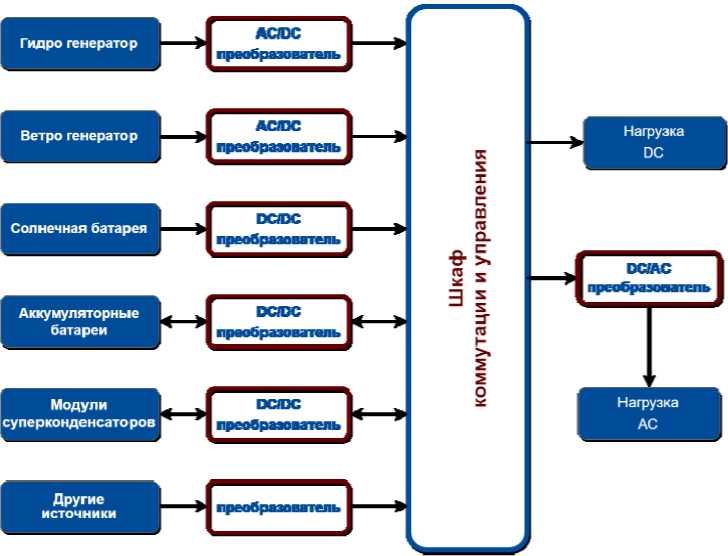
Рис. 1. Структурная схема автономной системы электроснабжения LVDC
Обоснование выбора типа
DC/DC-преобразователя
Режим управления DC/DC- системы преобр а зования мощности может быть реализован разли ч ными схемными топологиями [2]. Среди них баз овые и наиболее часто используемые преобразов а тели: понижающий, повышающий, преобразоват ели типа CUK, ZETA и SEPIC.
В [3– 23] рассмотрены различные типы бе з- мостовых топологий преобразователей, больши н ство из которых основаны на конфигурациях п овышающего преобразо вателя. Основное их пр еимущество – это низкая стоимость. Тем не менее они обладают следующими недостатками [24]:
– отсутствие изоляции входа – выхода;
– высокие пульсации тока.
Главной особенностью преобразователей типа CUK, ZETA и SEPIC является то, что они могут работать как в повышающем режиме, так и в понижающем. В [25] приведены результаты сравнения указанных преобразователей. Показано, что преобразователь CUK имеет более высокий уровень импульсных помех и длительность переходного процесса. Характеристики SEPIC и ZETA показаны идентичными. Однако необходимо отметить, что конденсаторный фильтр, используемый для преобразователя SEPIC, составлял 80 мкФ, тогда как конденсатор, используемый в преобразователе ZETA, – 120 мкФ. Это позволяет утверждать, что применение конденсатора большей емкости может улучшить качество выходного напряжения в случае его использования с преобразователем SEPIC. При этом в преобразователе SEPIC не изменяется полярность выходного напряжения, что является преимуществом перед аналогами и благоприятно сказывается, при использовании микропроцессорного управления преобразователем. В [24, 26] и [27–33] рассмотрены преобразователи на основе различных топологий SEPIC, также была показана их способность преодолевать вышеуказанные проблемы повышающего преобразователя. Проведенный анализ и сравнение работы различных преобразователей постоянного тока в широком диапазоне мощностей [25] показал, что с помощью преобразователя типа SEPIC могут быть получены более низкие значения пульсаций напряжения и величины перерегулирования. Также преимуществом SEPIC является возможность обеспечения изоляции входа/выхода [34].
Топология модели преобразователя SEPIC
Первичный индуктивный преобразователь с одним переключателем (SEPIC), показанный на рис. 2, построен с использованием топологии повышающего преобразователя путем вставки конденсатора С 1 между индуктивностью L 1 и диодом D 1. Этот конденсатор позволяет обеспечить изоляцию между входом и выходом. При этом анод диода D 1 также подключен к индуктивности L 2 [35].
Количество обмениваемой энергии контролируется с помощью переключателя Q 1, который обычно является транзистором, таким как MOSFET или IGBT. Две разные конфигурации схемы в зависимости от состояния переключателя Q 1 для случая режима непрерывной проводимости показаны на рис. 3.
Преобразовательная техника

Рис. 2. Схема преобразователя SEPIC

а)

б)
Рис. 3. Анализ SEPIC: а – 1-й подинтервал; б – 2-й подинтервал
В течение первого интервала времени (0 ≤ t ≤ DT , где T – период следования импульсов, D – коэффициент заполнения), Q 1 включен, а диод D 1 выключен, как показано на рис. 3а, напряжение на индуктивности L 1 равно входному напряжению U g . Что касается напряжения на индуктивности L 2 , оно равно U C 1 . Энергия накапливается в индуктивности L 1 от источника. В то же время конденсатор C 1 питает индуктивность L 2. Таким образом, энергия внутри индуктивностей увеличивается в этот период [34, 36].
Во время второго интервала времени Q 1 выключен, а диод D 1 включен, согласно рис. 3б, напряжение на индуктивности L 2 является обратным по отношению к выходному напряжению. В течение этого периода конденсаторы заряжаются и накапливают энергию.
Применяя методы «приближения малых отклонений», «баланс вольт-секунд» и «баланс заряда конденсатора» [37], получим зависимость между входным и выходным напряжениями относительно коэффициента заполнения D :
и = — U. (1)
1-D 9
Определение параметровпреобразователя SEPIC
Изучив кривые напряжений и токов на индуктивностях L 1 и L 2 на конденсаторах С 1 и С 2, можно определить диапазон пульсаций тока на индуктивности и диапазон пульсаций напряжения на конденсаторах.
Д =u<;(2)
Д
Ди^ = С-№(4)
Ди = ДиС2 = Г—)2 -^^^.(5)
C2 1-D 2RC2
В [36] и в [38] упоминается, что допустимые пульсации тока индуктора соствляют 40 % (пик до пик) и пульсации напряжения конденсатора – 2 %. В [39] отмечается, что в импульсных источниках питания постоянного тока процентная пульсация выходного напряжения обычно составляет около 1 %.
Определение допустимой пульсации тока и напряжения необходимо при выборе структуры и параметров окончательной конструкции преобразователя и в основном зависит от условий применения. Например, в автомобильной промышленности конструкция преобразователя мощности должна быть надежной, иметь малый вес и иметь относительно небольшой объем, но при этом сохранять высокий КПД, а также быть устойчивым к электромагнитным помехам и низким колебаниям тока / напряжения. Это также может отразиться на топологии преобразователя [40].
Задавшись количеством приемлемых пульсаций тока на индуктивности и напряжения на конденсаторах в преобразователе SEPIC, исходя из необходимого выходного напряжения, можно определить параметры элементов преобразователя:
|
L i |
= и дРТ. 2ДЧ? |
(6) |
|
UnDT |
||
|
L2 |
2Д1Е2 ; |
(7) |
|
C i |
= f-D_V_UgL- ; V i-D 2КДдС1 |
(8) |
|
C 2 |
= r_L.) 2_U1L . i-D 2RAuC2 |
(9) |
Моделирование преобразователя SEPIC
Для проверки полученных уравнений реализована блок-схема типовой топологии преобразователя SEPIC в MATLAB/Simulink (рис. 4). Анализируя уравнение (1), мы видим, что значение рабочего цикла D определяет режим работы пре-
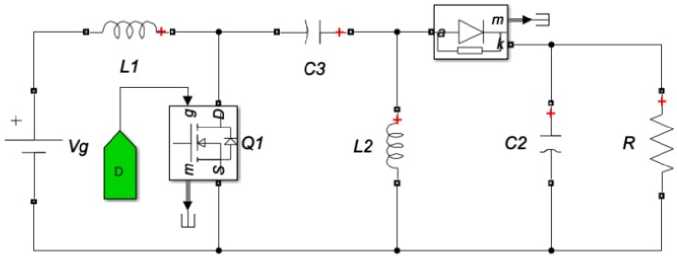
Рис. 4. Болк-схема преобразователя SEPIC в MATLAB
Таблица 1
Расчетные параметры SEPIC в режиме повышенной работы
|
Расчетные параметры |
|
|
Switching Frequency |
200 кГц |
|
Input Voltage |
500 В |
|
Output Voltage |
800 В |
|
Resistance Load |
5,333 Ом (120 кВт) |
|
Steady-State duty cycle D |
0,6154 |
|
Δ i L 1 |
15 % от IL 1 |
|
Δ iL 2 |
15 % от IL 2 |
|
L 1 |
21,368 мкГн |
|
L 2 |
34,188 мкГн |
|
Δ u C 1 |
1 % от UC 1 |
|
Δ u C 2 |
1 % от UC 2 |
|
C 1 |
46,154 мкФ |
|
C 2 |
28,846 мкФ |

Рис. 5. Результат моделирования SEPIC в режиме повышающего преобразователя
Преобразовательная техника образователя в качестве понижающего или повышающего. Когда D меньше 0,5, преобразователь действует как понижающий, а когда D больше 0,5, преобразователь повышает входное напряжение.
Рассмотрим случай, когда преобразователь SEPIC работает в повышающем режиме. Предполагается, что нагрузка является активной – 120 кВт. Параметры схемы преобразователя рассчитаны в соответствии с ранее полученными уравнениями и ограничениями пульсаций токов индуктивности и напряжений конденсаторов. Параметры приведены в табл. 1, а результаты – на рис. 5.
Далее рассматривается случай, когда преобразователь SEPIC работает в понижающем режиме. Нагрузка является также активной и имеет значение 120 кВт. Параметры схемы преобразователя рассчитаны в соответствии с ранее полученными уравнениями и ограничениями пульсаций токов индуктивности и напряжений конденсаторов. Все данные приведены в табл. 2, а результаты – на рис. 6.
Система состоит в основном из источника постоянного напряжения 500 В, и роль преобразователя SEPIC заключается в понижении подаваемого напряжения до 400 В при частоте переключения 200 кГц.
Результаты обоих режимов работы показывают реакцию преобразователя в соответствии с рассчитанными значениями элементов. Погрешность составила около 0,5 %.
Выполним моделирование режима стабилизации выходного напряжения на уровне 500 В при изменении напряжения в диапазоне ±40 %. Нагрузка преобразователя также будет иметь активный характер, величина 120 кВт. Все данные приведены в табл. 3, а результаты – на рис. 7 и 8.
Как показано на рис. 7 и 8, выходное напряжение зафиксировано на уровне 500 В. Однако стоит отметить, что, когда входное напряжение падает слишком сильно, в сигнале будет присутствовать влияние гармоник (без учета переходной реакций системы на контроллер).
На рис. 9 показана, коррекция коэффициента заполнения при изменении входного напряжения. Когда напряжение, подаваемое в преобразователь, ниже 500 В, SEPIC действует как повышающий преобразователь, и, следовательно, коэффициент заполнения будет выше 0,5. Однако когда входное напряжение выше 500 В, коэффициент заполнения будет меньше 0,5. Это значение автоматически контролируется на уровне контроллера.
Таблица 2
Расчетные параметры SEPIC в режиме понижающей работы
|
Расчетные параметры |
|
|
Switching Frequency |
200 кГц |
|
Input Voltage |
500 В |
|
Output Voltage |
400 В |
|
Resistance Load |
1,333 Ом (120 кВт) |
|
Steady-State duty cycle D |
0,4444 |
|
Δ i L 1 |
15 % от I L 1 |
|
Δ i L 2 |
15 % от I L 2 |
|
L 1 |
15,432 мкГн |
|
L 2 |
12,346 мкГн |
|
Δ u C 1 |
1 % от U C 1 |
|
Δ u C 2 |
1 % от U C 2 |
|
C 1 |
66,667 мкФ |
|
C 2 |
83,333 мкФ |
Buck Mode Operation

Рис. 6. Результат моделирования выхода SEPIC в режиме понижающего преобразователя
Таблица 3
Расчетные параметры SEPIC в режиме повышенной работы с изменчивым входным напряжением DC
|
Расчетные параметры |
|
|
Sw it ch i ng Fre qu en c y |
200 кГц |
|
D e si gn In p u t V olt ag e |
400 В |
|
O u tpu t V olt a g e |
500 В |
|
R es i s t a n ce Loa d |
2,0833 Ом (120 кВт) |
|
D e si gn du ty cy c l e D |
0,5556 |
|
Δ i L 1 |
15 % от I L 1 |
|
Δ i L 2 |
15 % от I L 2 |
|
L 1 |
12,346 мкГн |
|
L 2 |
15,432 мкГн |
|
Δ u C 1 |
1 % от U C 1 |
|
Δ u C 2 |
1 % от U C 2 |
|
C 1 |
83,333 мкФ |
|
C 2 |
66,667 мкФ |
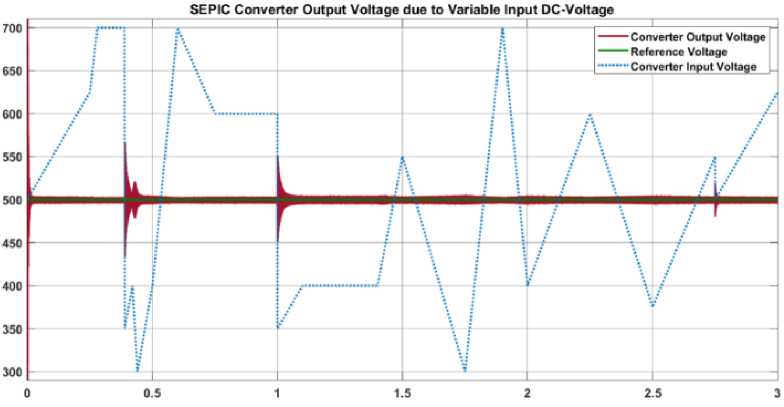
Рис. 7. Выходное напряжение SEPIC в режиме стабилизации напряжения
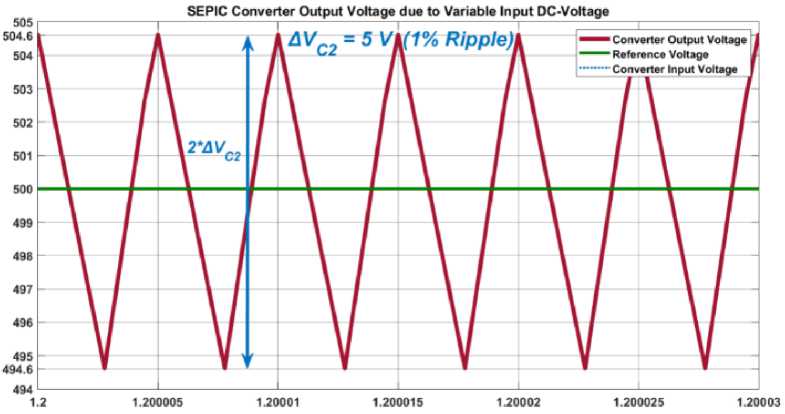
Рис. 8. Пульсация выходного напряжения
Преобразовательная техника
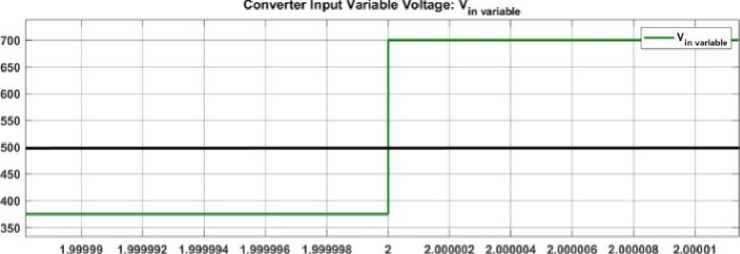

Рис. 9. Автоматическая коррекция коэффициента заполнения D
Выводы
Выполнен анализ DC/DC-преобразователей. Обосновано, что для систем автономного электроснабжения, имеющих в своем составе накопители электроэнергии (аккумуляторные батареи, модули суперконденсаторов), целесообразно применение преобразователя типа SEPIC.
Обоснован выбор параметров DC/DC-пре-образователя автономного источника электроснабжения. Проведено моделирование работы преобразователя в режимах повышения, понижения и стабилизации выходного напряжения в пакете MATLAB / Simulink. Результаты моделирования режимов работы показывают реакцию преобразователя в соответствии с рассчитанны- ми значениями элементов. Полученные результаты моделирования показывают эффективность предлагаемого решения для источника автономного электроснабжения. Погрешность составила около 0,5 %.
Преобразователи SEPIC могут быть использованы не только в системах автономного питания с накопителями энергии (аккумуляторными батареями и суперконденсаторными модулями), но также в системах коррекции коэффициента мощности, особенно в связи с развитием конденсаторов с низким эквивалентным последовательным сопротивлением (low-ESR, equivalent series resistance) [41], а также для фотоэлектрических станций и ветровых турбин.
Список литературы Обоснование параметров преобразователя постоянного тока для источника автономного электроснабжения
- Зотин О.Т. В преддверии возрождения постоянного тока. Силовая электроника. 2013. Т. 6, № 45.
- С. 7–14. [Zotin O.T. In anticipation of DC revival. Power electronics, 2013, vol. 6, no. 45, pp. 7–14. (in Russ.)]
- Denardo A., Femia N., Forrisi F., Granato M. SEPIC converter passive components design. 2008 IEEE 15th Electronics, Circuits and Systems (ICECS 2008), 2008, pp. 1002–1005. DOI: 10.1109/icecs.2008.4675025
- Mitchell D.M. ACDC converter having an improved power factor. Patent U.S., no. 4 412 277, 1983.
- Laszlo H., Yungtaek J., Jovanovic M.M. Performance Evaluation of Bridgeless PFC Boost Rectifiers. IEEE Transactions on Power Electronics, 2008, vol. 23, no. 3, pp. 1381–1390. DOI: 10.1109/tpel.2008.921107
- Tollik D., Pietkiewicz A. Comparative analysis of l-phase active power factor correction topologies. Proc. Int. Telecommunication Energy Conf., 1992, pp. 517–523. DOI: 10.1109/intlec.1992.268393
- Souza A.F., Barbi I. High power factor rectifier with reduced conduction and commutation losses. Proc. Int. Telecommunication Energy Conf., 1999, pp. 8.1.1–8.1.5. DOI: 10.1109/intlec.1999.794044
- Пирог С., Шклярский Я.Э., Скамьин А.Н. Идентификация местоположения нелинейной электрической нагрузки. Записки Горного института. 2019. Т. 237. С. 317–321. [Pirog S, Shklyarskiy Y.E., Skamyin A.N. Non-linear Electrical Load Location Identification. Journal of Mining Institute, 2019, vol. 237, pp. 317–322.] DOI: 10.31897/pmi.2019.3.317
- Salmon J.C. Circuit topologies for PWM boost rectifiers operated from 1-phase and 3-phase ac supplies and using either single or split dc rail voltage. Proc. IEEE Applied Power Electronics Conf., 1995, pp. 473–479. DOI: 10.1109/apec.1995.468990
- Woo-Young Choi et al. Bridgeless Boost Rectifier with Low Conduction Losses and Reduced Diode Re-verse-Recovery Problems. IEEE Transactions on Industrial Electronics, 2007, vol. 54, no. 2, pp. 769–780. DOI: 10.1109/tie.2007.891991
- Enjeti P.N., Martinez R. A high performance single phase AC to DC rectifier with input power factor cor-rection. Proc. IEEE Appl. Power Electron. Conf., 1993, pp. 190–195. DOI: 10.1109/apec.1993.290631
- Souza A.F., Barbi I. A new ZVS semiresonant high power factor rectifier with reduced conduction losses. IEEE Trans. Ind. Electron., 1999, vol. 46, no. 1, pp. 82–90. DOI: 10.1109/41.744393
- Moriconi U. A bridgeless PFC configuration based on L4981 PFC controller. Application Note AN 1606, 2002, pp. 1–18.
- Wang C.M. A novel zero-voltage switching PWM boost rectifier with high power factor and low conduc-tion losses. Proc. INTELEC., 2003, pp. 224–229.
- Moschopoulos G., Jain P. A novel single-phase soft-switched rectifier with unity power factor and minimal component count. IEEE Trans. Ind. Electron., 2004, vol. 51, no. 3, pp. 566–576. DOI: 10.1109/tie.2004.825334
- Ern T., Frisch M. Second generation of PFC solutions. Power Electron. Europe, 2004, no. 7, pp. 33–35.
- Salmon J.C. Circuit topologies for single-phase voltage-doubler boost rectifiers. Proc. IEEE Appl. Power Electron. Conf., 1992, pp. 549–556. DOI: 10.1109/apec.1992.228362
- Lykov Y.V., Gorelikov V.G., Baatarkhuu G. Analytical research and classification of mechanism of dia-mond drilling-bits contact with rocks during well sinking. 2017 IOP Conf. Ser.: Earth Environ. Sci. 87 022012, 2017. Available at: https://iopscience.iop.org/article/10.1088/1755-1315/87/2/022012 (accessed 15.02.2020). DOI: 10.1088/1755-1315/87/2/022012
- Ye H. et al. Common mode noise modeling and analysis of dual boost PFC circuit. Proc. Int. Telecom-mun. Energy Conf., 2004, pp. 575–582.
- Lu B., Brown R., Soldano M. Bridgeless PFC implementation using one cycle control technique. Proc. IEEE Appl. Power Electron. Conf., 2005, pp. 812–817. DOI: 10.1109/apec.2005.1453073
- Kong P., Wang S., Lee F.C. Common mode EMI noise suppression in bridgeless boost PFC converter. Proc. CPES Power Electron. Conf., 2006, pp. 65–70.
- Wei H., Batarseh I. Comparison of basic converter topologies for power factor correction. Proceedings IEEE Southeastcon '98 'Engineering for a New Era', Orlando, FL, USA. 1998, pp. 348–353.
- Gorelikov V.G., Lykov Y.V., Baatarkhuu G. Analytical and Experimental Study of the Mechanisms of Diamond Bits Interaction with Rocks in the Wellbore During Sinking Processes. International Journal of Applied Engineering Research, 2016, vol. 11, no. 10, pp. 7012–7016. Available at: http://www.ripublication.com (ac-cessed 10.02.2020).
- Wang C.M. A novel single-stage high-power-factor electronic ballast with symmetrical half-bridge topo-logy. IEEE Trans. Ind. Electron., 2008, vol. 55, no. 2, pp. 969–972. DOI: 10.1109/tie.2007.896556
- Ismail E.H. Bridgeless SEPIC Rectifier with Unity Power Factor and Reduced Conduction Losses. IEEE Transactions on Industrial Electronics, 2009, vol. 56, no. 4, pp. 1147–1157. DOI: 10.1109/tie.2008.2007552
- Singh K., Singh M. Analysis and Comparison of Performance of Various DC-DC Converters using MATLAB SIMULINK. International Journal for Scientific Research & Development, 2015, vol. 3, iss. 08.
- Sahid M.R., Yatim A.H.M., Taufik T. A new AC-DC converter using bridgeless SEPIC. IECON 2010 – 36th Annual Conference on IEEE Industrial Electronics Society, Glendale, AZ, 2010, pp. 286–290. DOI: 10.1109/iecon.2010.5675012
- Sebastian J. Improving power factor correction in distributed power supply systems using PWM and ZCS-QR SEPIC topologies. Proc. IEEE Power Electron. Spec. Conf., 1991, pp. 780–791. DOI: 10.1109/pesc.1991.162764
- Cuk S., Brkovic M. Input current shaper using Cuk converter. Proc. Int. Telecommun. Energy Conf., 1992, pp. 532–539. DOI: 10.1109/intlec.1992.268391
- Simonetti D.S.L., Sebastian J., Uceda J. The discontinuous conduction mode Sepic and CUK power factor preregulators: Analysis and design. IEEE Trans. Ind. Electron., 1997, vol. 44, no. 5, pp. 630–637. DOI: 10.1109/41.633459
- Spiazzi G., Rosseto L. High-quality rectifier based on coupled-inductor Sepic topology. Proc. IEEE Appl. Power Electron. Conf., 1994, pp. 336–341. DOI: 10.1109/pesc.1994.349712
- Dos Reis F.S., Sebastian J., Uceda J. Characterization of conducted noise generation for Sepic CUK and Boost converters working as power factor preregulators. Proc. IEEE IECON ‘93, 1993, vol. 2, pp. 965–970. DOI: 10.1109/iecon.1993.339144
- Guerra Dand Iakovleva E 2019 E3S Web Conf. 140 4013.
- Zhang H., Yi C., Wei T. Nonlinear Modal Analysis of Transient Interaction Behaviors in SEPIC DC-DC Converters. IET Power Electron., 2017, vol. 10, iss. 10, pp. 1190–1199. DOI: 10.1049/iet-pel.2016.0858
- Li N. et al. Digital control strategies for DC/DC SEPIC converters towards integration. INSA de Lyon, 2012. English. Available at: https://tel.archives-ouvertes.fr/tel-00760064 (accessed 10.02.2020).
- Anuradha C., Sakthivel C., Venkatesan T., Chellammal N. Analysis of Non-Isolated Multi-Port Single Ended Primary Inductor Converter for Standalone Applications. Energies, 2018, vol. 11 (3), p. 539. DOI: 10.3390/en11030539
- Rose J.L., Sankaragomathi B. Design, Modeling, Analysis and Simulation of a SEPIC Converter. Middle-East Journal of Scientific Research, 2016, vol. 24 (7), pp. 2302–2308. Available at: https://www.idosi.org/mejsr/mejsr24(7)16/20.pdf (accessed 27.02.2020).
- Erickson R.W., Maksimovic D. Fundamentals of Power Electronics. 2001, Boston, MA: Springer US. 912 p.
- Zhang D. Revised 2013 AN-1484 Designing A SEPIC Converter (Rev. E). Available at: https://www.ti.com/lit/an/snva168e/snva168e.pdf (accessed 27.02.2020).
- Mohan N., Undeland T.M., Robbins W.P. Power Electronics. Converters, Applications, and Design. Hoboken, N.J., John Wiley & Sons, 1995. 667 p.
- Al Sakka M., Van Mierlo J., Gualous H. DC/DC Converters for Electric Vehicles, Electric Vehicles. Model-ling and Simulations, Seref Soylu, IntechOpen, 2011. DOI: 10.5772/17048. Available at: https://www.intechopen.com/books/electric-vehicles-modelling-and-simulations/dc-dc-converters-for-electric-vehicles (accessed 27.02.2020).
- SEPIC Equations and Component Ratings [Electronic Resource]. Maxim Integrated: Technical Docu-ment. 2002. Available at: https://pdfserv.maximintegrated.com/en/an/AN1051.pdf (accessed 01.03.2020).

